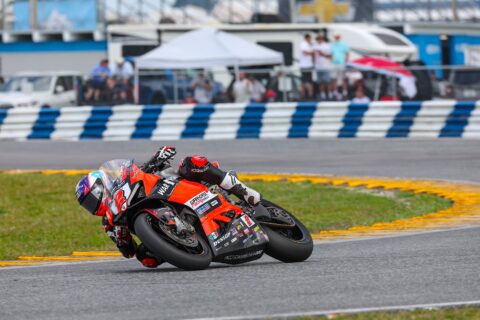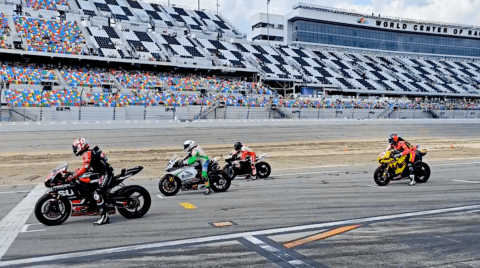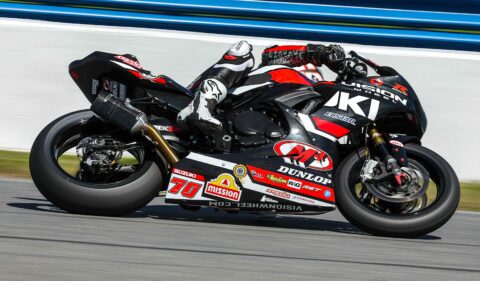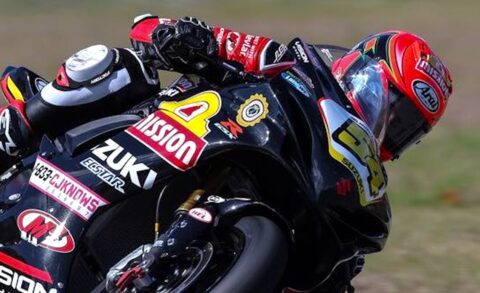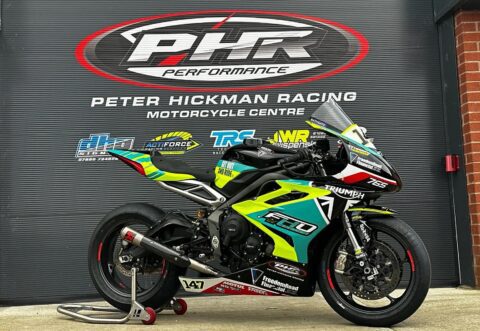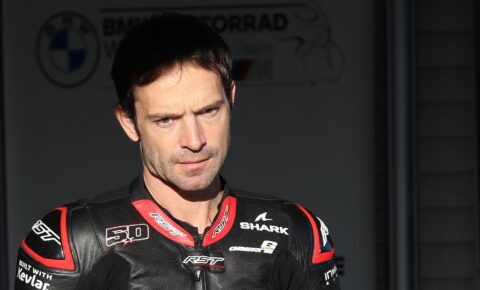Take aspects of the race-winning BMW M 1000 RR, and add advanced rider aids to create the new S 1000 RR. It’s not just good, it’s very good.
The RR embraces the steering geometry, adjustable swing-arm pivot and ride height adjustment of the M-Sport, plus a few more top-end horsepower from the excellent ShiftCam engine along with a pair of distinctive aero wings, similar but noy identical to the M-Sport.
Electronics have taken a significant step forward with a new DTC Side Control, MSR engine brake torque control system, BSA Brake Slide Assist, ABS Pro, which is cornering ABS for use on track with slicks fitted, which the old bike didn’t have. There is even ABS Stoppie feature for returning down pit lane. Many of these new features are due to the new steering angle sensor, which is new for this class.
BSN headed to Almeria in Spain to see if the new S 1000 R can make you ride like God, or at least make you feel like you can.
Around the track
Changes to the chassis are not spectacular and fundamentally stolen from the proven M 1000 RR. The wheelbase is nearly the same as the M and the steering is more relaxed. The S 1000 RR also gets the M chassis kit, with an adjustable swingarm pivot point, and ride height. As fitted to our test bike, electronic damping adjustment is an optional extra with the DDC ‘Dynamic Damping Control’ package, (Dynamic Package heated grips, cruise control, dynamic damping, riding modes pro £1,400) altering the suspension settings to suit the selected riding mode.
Quoted weight remains the same, 197kg fully-fuelled for the standard bike, 195.4kg with the optional ‘Race Package’ that adds forged alloy wheels instead of die-cast rims, and 193.5kg with the ‘M Package’ option that swaps them for lightweight carbon wheels, which were fitted to our test bike, (M Pack carbon wheels, M colour, M Seat - £4,480). For reference, we also had the Performance Package (slip-on exhaust plus endurance chain) - £925. This came to a total price of £23,955. Yes that is considerably more than the £17,150 base price, but on par with the Honda Fireblade SP, which appears to be the bike of choice next year in British Superstock.
The Flex Frame uses the engine as a stress member, the wheelbase has increased and chassis dimensions are more relaxed, the steering head angle is shallower, as mentioned very similar to the M 1000 RR. Wing appears for the first time, generating up to 17.1kg of downforce at 300kph, or 186mph, 7.6kg at 200kph, 11.9kg at 250kph. If you don’t have wings, you’re not in the fight.
We had perfect conditions in southern Spain in Almeria as well as pre-heated Bridgestone slicks. BMW fitted the M-Sport carbon wheels and set the DCT suspension to match the high-grip tyres and track temperatures. Conditions could not have been better.
The changes are not enormous but are significant. BMW didn’t need to do much with an already excellent bike. Within a few laps, you feel at home on the S 1000 RR; like a bike you’ve been racing all season. You immediately click and understand how the new chassis translates to the rider. This is not an edgy, 200bhp plus racer.
The BMW isn’t a razor-sharp, aggressive sports bike as its aggressive ‘winged’ looks indicate. Instead, it’s its ease of use that shines. The steering is superb. Apexes are hit with perfect accuracy lap after lap and with relatively little effort. You don’t have to force it, laps become a natural flow.
Mid-corner grip and feedback are excellent. Get on the power early and, instead of drifting wide, the BMW continues to hold a line.
Stability, too, is unyielding. Towards the end of the Almeria lap there’s a tight chicane where you make some time by clipping or riding over the kerbs. In the morning I was hitting the kerb harder and harder, leaning over further, even braking deep over the first kerb – yet the S 1000 RR never skipped, slid or showed any indication of waywardness.
With the large TFT dash reading just over 280kph at the end of the straight, high-speed stability wasn’t in question either. The new, larger screen, almost TT like, takes the majority of the wind blast so you can get tucked in, relax and release your grip from the bars, which remain unflappable. It’s hard to be certain but this may in part be down to the new aerodynamics as well as to chassis changes like a longer wheelbase. You’re not holding on at the end of the straight, arms pumped, instead you’re relaxed, concentrating on your marker.
ABS Pro is new for 2023 and is essentially cornering ABS designed to work with slick tyres (with optional Pro mode). Combine that with the new MSR engine brake control, and BSA Brake Slide Assist (in optional Pro mode) and it’s a remarkable braking package.
It’s incredible what you can get away with, and almost takes the calculation of braking out of the rider’s hands, it’s that good. The ABS Pro is designed to work with slick rubber and allows you to brake breathtakingly deep and late without fear of locking the front tyre. Just pull the level as hard as you can and allow the tech to take over.
The new BSA works with the ABS and the MSR and is for track use. The clutch must be engaged, revs need to be high, and deceleration needs to be rapid. This new clever system work with the new steering head sensor, plus other parameters like brake pressure, rpm, gear, etc again information from the 6-axis IMU.
The system, which features a new steering head sensor and draws on parameters such as brake pressure, can calculate how much you are steering into a slide when braking heavily and the rear end starts to come around or ‘back in’. It took me most of the day before I could jump on the brakes (front and rear) and allow the system to bring the rear back in line with the front. I’m no WSBK rider, far from it, and it took me a while to activate the system and then trust it. But when the system kicks in, it’s impressive. Again, we had perfect conditions in Spain, slicks, and huge amounts of grip. In theory, it should be ‘easier’ to feel the system work, on track day rubber on British tracks – can’t wait to try.
More tech than before
The introduction of the ‘Slide Control’ function allows the rider to preselect one of two possible drift angles that can be achieved before the Dynamic Traction Control system intervenes. That’s right in theory you can now drift. The clever system uses the prementioned new sensor on the bike’s steering angle, a bit like an old-fashioned steering damper, to work out how far out of line the rear wheel is. The BSA Brake Slide Assist uses the same sensor, along with other data, including information from the IMU. In theory, you can now slide and steer from the rear.
The system is impressive, but to feel the system working or steer from the rear, you have to be brave of skilful. To start with, you have to turn down the DTC (traction control) enough to get the rear spinning because you can’t power slide unless the rear is spinning and has lost grip. I’m assuming most riders won’t be able to get the Bridgestone slick to ‘let go’ in perfect conditions in sunny Spain.
After six long sessions on the same rear tyre, I still don’t think I managed to provoke a true power slide that activated the system despite feeling brave. But similar to other rider aids, it’s nice to know it’s there in the background, should you make a mistake. And when the grip is less, in the UK or a worn tyre it might be easier to provoke a slide. I’m thinking Donigton Park in March.
Power
Torque remains unchanged at 113Nm (83.3lb-ft) at 11,000rpm but they have added an extra tooth on the rear sprocket. Peak power is up a fraction, 154kw or 206.5bhp/210hp. Peak power is higher up the rev range at 13,750rpm, just 250rpm higher. It is not a massive jump in power, but it didn’t need to be.
Honestly, the S 1000 RR didn’t need any more horses in the first place. The slight increase will only be noticeable when ridden back-to-back with the now-old bike. The change to the final gearing is more noticeable, creating quicker acceleration.
Engine performance on the track is fantastic but very similar to the old bike. Power delivery is anything but peaky; you don’t need to be in the last 20% of the rev range to make things happen. Instead, the RR pulls cleanly through its midrange, and you can even afford to short shift to give the electronic rider aids an easier time. Equally, you can bounce the S 1000 RR off its soft rev limiter and make it scream. The shift-cam engine is versatile for a 1000cc sports bike. You don’t have to be a former racer to get the most from it.
The fuelling is superb. You can be so precise with the throttle, getting on the power sooner and sooner. There’s no scratchiness, which gives the rear hoop an easier life, and allows you to accelerate progressively, feeling the grip.
The usability of the motor, backed up by new and advanced rider aids, means you can use the motor to its full potential. For a 207bhp rocket, the RR is incredibly easy to use and probably the least intimidating bike in this class. I’ll take a usable 207bhp over a peaky 230bhp all day long. All too often ‘rider/racers’ are concerned with bragging rights down the pub, 220bhp or more. But if you can’t use the power it’s wasted. This is the key to the BMW, you can use the power, even riders who are relatively new to track riding.
Verdict
The big decision is should I buy an S 1000 RR for 2023? It depends on where and how you ride. If you ride mainly on the road, honestly, you won’t feel the few BHP increases, the wings only really work at double the national speed limit, and I doubt you’ll be steering with the rear on the road. This doesn’t mean the new bike is an excellent road bike, it is, heated grips and cruise control, but so was the now-old bike.
However, if you ride mainly on track or just the track then the new bike is very tempting, very. The new bike is more accessible and usable than before. The RR feels as friendly as a respectable supersport 600. It’s so unintimidating you can just jump on and enjoy it, all day.
The changes to the chassis, even the addition of new aerodynamic wings, aren’t revolutionary, but certainly make a difference, dependant on speed, and are proven to work on the M-Sport, BSB, and TT wins. The wings will certainly help on some undulating tracks we have in the UK.
The conditions and spec of the bike in Spain were ideal, carbon wheels, sunny, and perfectly set up – but even so the handling package is impressive. The chassis’ feedback, stability, and huge stopping power are hard to find any fault with. Yet despite cutting some fast laps, (ish) I never felt like I was in a fight with a 200bhp monster, in fact after a full day on track I still wanted more.
Some of the rider aids may only appeal to highly skilled riders, but the traction control is superbly effective and the updated quick-shifter is near as dam it, picture-perfect. The engine, chassis, and rider aids are so good, it’s so rewarding and easy to ride, the RR really feels like an arcade game. I can’t remember riding a 1000cc superbike, which was this friendly, both in terms of electronics, chassis, engine, and rider aids. I can’t wait to test the S 1000 RR again in the UK, in less-than-perfect conditions. I’m unsure if it will lap quicker than a Ducati Panigale or Honda Fireblade, but it’s possibly easier. Hopefully, we will bring you that test shortly.
Tech Spec
Capacity 999cc
Bore x Stroke 80 x 49.7mm
Engine layout Liquid-cooled inline four cylinder
Engine details ShiftCam variable valve timing and lift, DOHC
Power 154kW/206.5bhp @ 13,750rpm
Torque 113Nm / 83.3ft lbs @ 11,000rpm
Top speed 188mph
Transmission Six-speed, standard quickshifter
Average fuel consumption Claimed: 44.4mpg / 6.4l/100km
Tank size 16.5 litres
Max range to empty 160 miles claimed
Rider aids Cornering traction control and ABS, slide control, brake slide assist, riding modes, optional electronic damping control
Frame Die-cast aluminium ‘Flex Frame’
Front suspension 45mm USD forks
Front suspension adjustment Adjustable compression, rebound and preload. Optional DDC electronic adjustment
Rear suspension Underslung double sided swingarm with central spring strut
Rear suspension adjustment Adjustable compression, rebound and preload. Optional DDC electronic adjustment
Front brake Twin 320mm discs, four-piston radial calipers
Rear brake Single 220mm disc, single-piston caliper
Front wheel / tyre Cast alloy, 120/70 ZR17 (optional forged alloy or carbon wheels)
Rear wheel / tyre Cast alloy, 190/55 ZR17(optional forged alloy or carbon wheels)
Dimensions (L x W x H) 2073mm x 846mm x 1155mm
Wheelbase 1457mm
Seat height 824mm
Weight 197kg (wet)
Warranty 3-year, unlimited mileage
Servicing 6000 miles or annually


